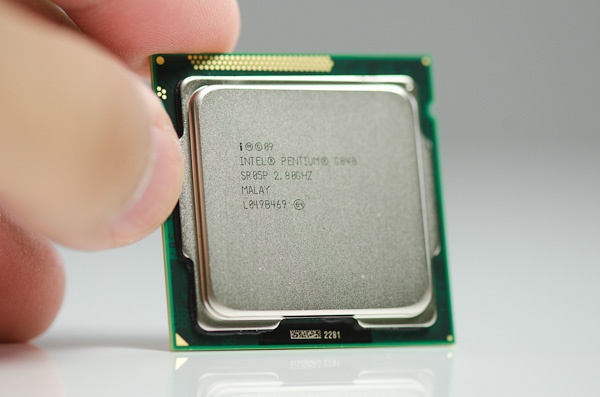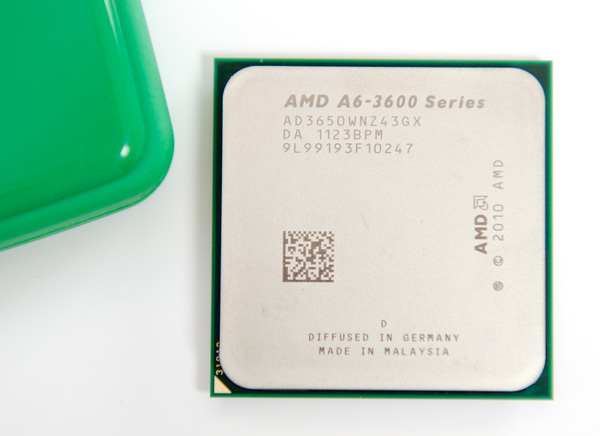The Sandy Bridge Pentium Review: G850, G840, G620 & G620T Tested
by Anand Lal Shimpi on August 23, 2011 12:11 AM ESTFinal Words
Despite boasting Intel's latest Sandy Bridge microarchitecture, the conclusions here are pretty much unchanged from the past. Intel maintains an advantage when it goes up against an AMD chip with the same number of cores, almost regardless of clock speed. In the case of the Pentium G620, even an Athlon II X2 265 with a 27% clock speed advantage can't outperform the Sandy Bridge based CPU. If you're choosing between chips with the same number of cores at the same price, Intel wins.
The decision tilts in AMD's favor if you start comparing to the Athlon II X3. In heavily threaded workloads, the Athlon II X3's third core helps put it ahead of the entire SNB Pentium lineup. If you're building a machine to do offline 3D rendering, multithreaded compiling or video transcoding then AMD continues to deliver the best performance per dollar. It's in the lighter, less threaded workloads that the Pentium pulls ahead. If you're building more of a general use system (email, web browsing, typical office applications and even discrete GPU gaming), the Pentium will likely deliver better performance thanks to its ILP advantages. What AMD has offered these past couple of years is an affordable way to get great multithreaded performance for those applications that need it.
Unfortunately the entire Sandy Bridge Pentium lineup is clock locked. Without turbo modes there's no support for overclocking at all. While these new Pentiums would have normally been great for enthusiasts looking to overclock, Intel has ensured that anyone looking to get more performance for free at the low end will have to shop AMD. Unfortunately Intel's advantage in single/lightly threaded performance is big enough that a clock speed advantage alone is generally not enough to make up for it (see G620 vs. Athlon II X2 265 comparison). It's sad that it has come to this. I was hoping we'd see more K-series SKUs at the low end but it seems like those will only be for the enthusiasts at the high end.
The Pentium's on-die GPU isn't particularly impressive. It's the HD Graphics 2000 from the rest of the Sandy Bridge lineup without Quick Sync or any of the extra video features. I am particularly sad that Quick Sync is missing as it would've made these Pentiums extremely attractive for users that do a lot of video transcoding. Thankfully video decode acceleration and HD audio bitstreaming support remain, so if you're looking to build a cheap Sandy Bridge based HTPC and don't care about the frills these chips will work just fine.
However, if you're building a system to do any sort of 3D gaming you're much better off either springing for a cheap discrete card or looking at AMD's A6-3650 if you want to stay integrated. Although you can play older titles at low resolution on the Pentium's on-board GPU, you'll have a much better experience with a discrete GPU or with the A6.
It all boils down to this. If you want a good, cheap, general purpose PC then the Pentium G620 seems competent and cheap. You can consider the G840 if you want a bit more performance. If you do a lot of threaded work (e.g. offline 3D rendering) the next step up is the Athlon II X3 455. If you do any amount of consumer level video transcoding using apps that are Quick Sync enabled, opt for the Core i3 2100 instead. If gaming is important to you then either buy a discrete GPU or look to AMD's Llano.
As far as AMD's A6 vs. A8 goes, the A8-3850 only commands a $20 price premium over the A6-3650. That $20 gives you another 8 - 10% on the CPU side and around 20% on the GPU. In my opinion, if you're considering a Llano system - spring for the A8.












110 Comments
View All Comments
yo2020 - Tuesday, August 23, 2011 - link
for both idle and load. :DHavor - Tuesday, August 23, 2011 - link
For anyone that wants to build a low power system, dont look for a 620T or 2100T, they will only cost you actually more money and save's you almost no energy or even cost you extra if you do heavy loads like encoding.After looking up a lot of sites and comparing idle loads i made the following list, and radical changed the dissension on what CPU to use for my server.
CPU (total system use) Idle/Load
E-350 26W /38W
Pentium G620 Undervolt @ 0.9GHz 31W/43W
Pentium G620 31W /60W
Pentium G840 31W /60W
Pentium G850 32W /65W
Core i3 2100 33W /69W
Athlon X2 240e 34W/84W
i3 2120 33W /84W
i5 2400 34W /99W
i5 2500K 34W /110W
i7 2600K 35W /125W
i7-2600K (4.85GHz) 39W/190W
The idle difference between a G620T and a i7 2600K is only 4 watts, and yes under load the 2600K uses 2x the amount of watts, but at the same time it also dose 4x the amount of work, so with the "instruction per watt" (IPW) you are better of with a 2500K/2600K
So now I turn my main system of when i dont need it, and let my server that's 24/7 on anyway, do all the work.
So if a system is needed that needs to do heavy CPU work like encoding, but you still want a energy lean machine, a fast CPU could not be suds a bad idea after all.
Just something to think about ;-)
Marlin1975 - Tuesday, August 23, 2011 - link
These are well suited for HTPC but you did not compare them in that regard?Very few care about synthetic benchmarks, test these for real world uses like HTPC where many are looking to use low-end cpus like these.
Also you can still overclock the intel cpus just not much. Why not overclock the A6/A8 and the intel chips to compare as well?
dubyadubya - Tuesday, August 23, 2011 - link
Seems everyone has forgotten about 64 bit programs. There is zero mention of 64 bit programs in most reviews on the net. Testing using mainly 32 bit programs and not stating which programs are 32/64 bit give the impression that Intel's SB is way faster than AMD's offerings. AMD offerings perform much better running 64 bit code than Intel's SB so lets see some multi-threaded 64 bit testing.Traciatim - Tuesday, August 23, 2011 - link
Benchmark links?A5 - Tuesday, August 23, 2011 - link
You're going to have to back that up.silverblue - Tuesday, August 23, 2011 - link
Either you're saying that AMD's CPUs perform better in 64-bit mode than 32-bit mode, or that AMD's CPUs are better at x86-84 than Sandy Bridge. Regardless, as stated, you'll need to provide some evidence to back this up.AngryMonkeyMob - Tuesday, August 23, 2011 - link
While it is true that AMD can keep competitive on price/performance, when it comes to power consumption AMD gets it the hot bullets of shotgun when compared to Intels baked goods. That matters to some people ( it does to me ). I'd use this in a tiny ITX machine with something like this http://www.logicsupply.com/products/ga620ibk_a1...But I'd imagine that makes me a minority around here :)
Death666Angel - Friday, August 26, 2011 - link
If you do something that specific, surely you know how to undervolt a CPU? :-) AMDs Llano can be undervolted quite heavily as far as I know and the 65W TDP chips (A8-3800 and A6-3600 afaik) will already perform much more energy conscious out of the box. :-)CeriseCogburn - Monday, June 25, 2012 - link
Since you quibble on 5 or 20 bucks when it comes to a crap apu, and spend minimum $124.00+ on a tiny computer case, yes, I'd say, God Willing, you are in the minority around here, but I fear, that you definitely are not.Oh the irony